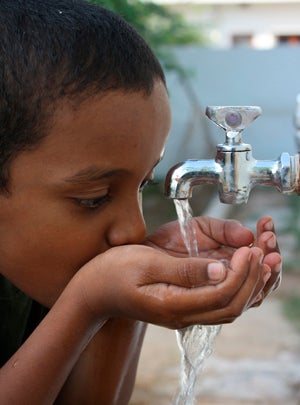
Nanotech device could save thousands of lives
Waterloo researchers invent nano-sensor that quickly detects drinking water contaminants. Warnings are sent through social media

Waterloo researchers invent nano-sensor that quickly detects drinking water contaminants. Warnings are sent through social media
By Staff Office of ResearchA $20 sensor invented by two University of Waterloo researchers could save lives by letting ordinary people detect contaminated drinking water using their cell phone.
“No one should ever have to become sick or die from contaminated food or water,” says Simarjeet Saini, a professor in the Department of Electrical and Computer Engineering. “This sensor could save thousands of lives.”
Water safety is a major global concern, especially in countries such as India and China where an estimated one billion people lack access to clean drinking water. Water safety testing currently requires expensive, specialized equipment not accessible to the average citizen.
 Saini, who is also with the University's Waterloo Institute for Nanotechnology (WIN), worked with post-doctoral research fellow Mohammadreza Khorasaninejad to develop a nano-photonic chip called a Surface Plasmon Array Sensor (SPiAS). Nanotechnology involves developing devices that are measured in nanometers. A human hair is about 100,000 nanometres wide.
Saini, who is also with the University's Waterloo Institute for Nanotechnology (WIN), worked with post-doctoral research fellow Mohammadreza Khorasaninejad to develop a nano-photonic chip called a Surface Plasmon Array Sensor (SPiAS). Nanotechnology involves developing devices that are measured in nanometers. A human hair is about 100,000 nanometres wide.
Used with the camera and processor of a standard cell phone, the SPiAS becomes an optical sensor that can detect pathogens.
The SPiAS chip has receptors that reflect vivid colors when lit by a simple white LED. Pathogens in the water sample bind to the receptors in the chip, which leads to a change in the sensor’s colour, indicating that the water is contaminated.
A cell phone is used to capture and analyze the sensor’s image for color changes. Water quality data can then be transmitted using wireless networks to a central server and distributed by social media to warn people that use the water source. The research was sponsored by a Discovery grant from the Natural Sciences and Engineering Research Council of Canada (NSERC).
Saini got the idea for the sensors from butterfly wings. “I have always been fascinated by these beautiful nanostructures,” he says. Once, while viewing a butterfly wing under a microscope, he accidentally dropped some water on it and the color changed. This got him thinking about whether he could generate colors in chips.
Currently, it takes days to process water samples and other optical chips being researched require expensive equipment. This new method is quick and inexpensive and uses the connectivity of cell phones to rapidly warn people about contaminated water.

Read more
Here are the people and events behind some of this year’s most compelling Waterloo stories

Read more
Meet five exceptional Waterloo graduate students crossing the convocation stage as Class of 2025 valedictorians

Read more
Waterloo Engineering alum wears her iron ring proudly while building her career in quantum tech in Germany
The University of Waterloo acknowledges that much of our work takes place on the traditional territory of the Neutral, Anishinaabeg, and Haudenosaunee peoples. Our main campus is situated on the Haldimand Tract, the land granted to the Six Nations that includes six miles on each side of the Grand River. Our active work toward reconciliation takes place across our campuses through research, learning, teaching, and community building, and is co-ordinated within the Office of Indigenous Relations.